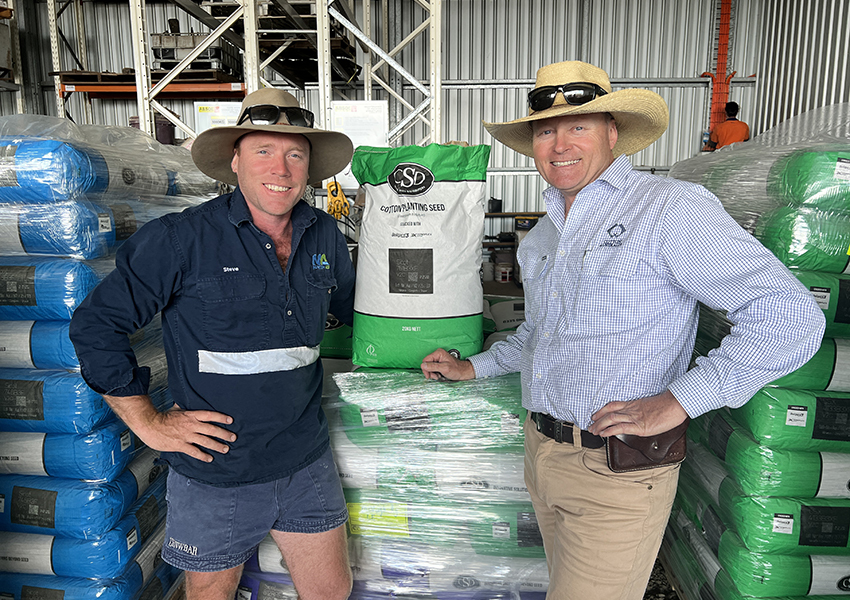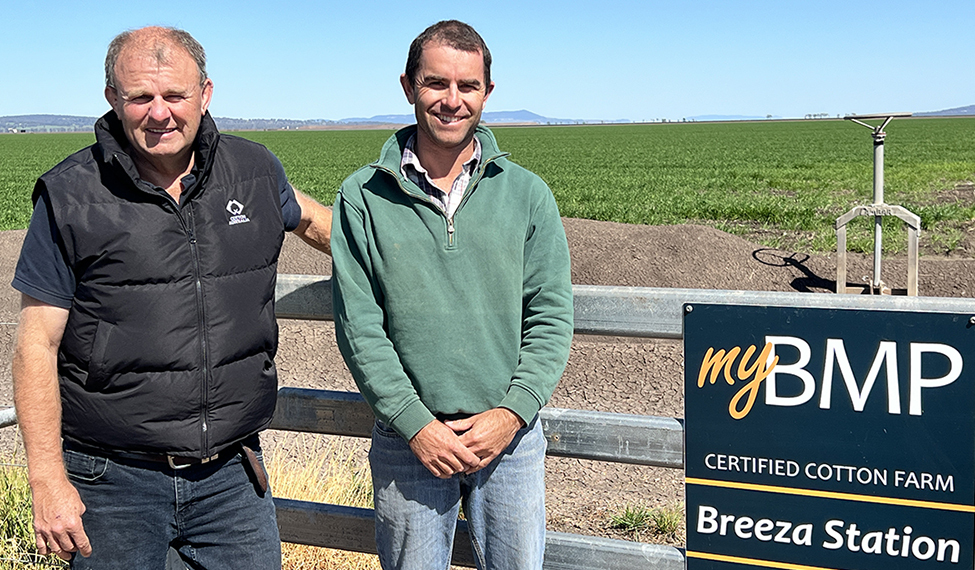- Home
- News Stories
- Cotton growers in for another good season with some crops already out of the ground
Cotton growers in for another good season with some crops already out of the ground
In a season launch that showcases the diversity of the cotton growing landscape in Australia, growers are already celebrating healthy looking crops coming out of the ground in Central Queensland
At least 80% of the crop is already planted in the Central Highlands with favourable conditions allowing growers to plant into moist soil in August.
Emerald grower and the Chair of the Cotton Australia Board, Nigel Burnett, said with carryover from last season and a welcome allocation from Fairbairn Dam, growers are confident.
“We had unseasonal rainfall in August and that enabled a good chunk of the area to be moisture planted, saving farmers from the initial flush-up irrigation and those crops are now out of the ground and looking very good.
“Since planting the conditions have been warming up and growers are confident about the prospects for the season at this stage.
“I have planted more than 700 hectares so far and if there’s more rainfall over the coming weeks and months, I would look at planting more cotton into late October, November or even December.”
For Darling Downs grower Steve McVeigh, the 2024 AgriRisk High Achiever of the Year, planting is now underway.
“We are running the planters into a dryland field and our irrigated cotton will go in around the 14th of October. It’s about getting our timing perfect, and our plans are in place so it’s all systems go.”

James Kahl from Wee Waa in NSW said he is due to start planting 714 cotton as soon as they hit a ten-day warm snap with the rest going in around mid-October.
“All our cotton ground is ready to go with the preparation done and the soil and seed beds in perfect condition. We can’t get off to a much better start than this and the only thing that could mess that up is an unforeseen cold snap.
“We expect an above average season as with 50% of our farm going to cotton each year and then a series of rotation crops. We grow cotton every second year in a particular field and that helps with carbon loading.
“The Bureau of Meteorology seems to have it about right at the moment and we are three years into a seasonal wet cycle and despite the chance of an occasional dry spell we are confident of sufficient rain for a decade before the next dry cycle,” Mr Kahl said.
James Pursehouse from Breeza on the Liverpool Plains has had good winter rain, and he says conditions are shaping up well for a healthy cotton crop. “We’ve been growing cotton for over 40 years, dryland and under irrigation, and while we operate under shorter and cooler temperatures than Narrabri and Moree our gross margin still makes it profitable.
“We will be planting in the second week of October as a rule of thumb dependent on soil temperature which might see us go a bit earlier. We have full storages on farm with recent rain and flooding events we have good access to water for irrigation, with good profile and stubble cover for dryland.”
Tim Gainsford runs the family farm at Narromine and is planting 115 hectares of cotton this year, 50 hectares back-to-back after trialling cover cropping on the remainder to penetrate the hard red soil.
“Last year was the first we established a cover crop to plant cotton into. We did our cotton preparation earlier, spread wheat over, established a crop then sprayed it out before head emergence, then planted cotton straight into that without any prep work.
“The root structure in the cover crop made the soil softer and more moisture was retained which gave better conditions for seed. With this red soil were able to establish roots through the profile and the water followed those paths to penetrate to depth drawing nutrients and water to the full soil profile. We averaged one and a half bales per hectare better than our last record and two and a half bales better on the clay soils.”
Cotton Australia General Manager Michael Murray said the signs for this season are positive with Australia’s 1500 cotton growers, 90% of them family farmers, expecting to generate around 4.4 million bales or one million tonnes of quality fibre, bound for export markets.
“This year we are expecting about 400,000 green hectares to be planted, predominantly in New South Wales and Queensland with crops also being planted in the Northern Territory and Western Australia.
“A result in line with expectations will see more than $3.1 billion generated for the national economy with most of that money filtering down into the 249 communities that benefit directly from cotton growing.”

